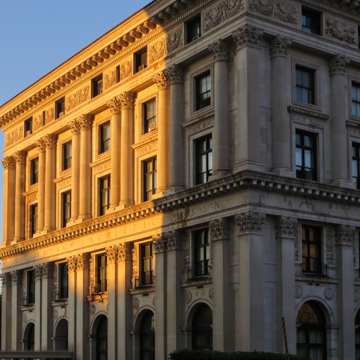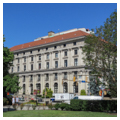The Civic Center portion of Franklin Nicola's dream continued with the construction of the Pittsburgh Athletic Association (PAA) (1909–1911, Janssen and Abbott; 4215 5th Avenue), which jump-started Oakland's building boom and Benno Janssen's lucrative career as a Pittsburgh society architect. Architectural critic Montgomery Schuyler deemed the PAA one of Pittsburgh's outstanding buildings and Janssen its best architect, when he wrote about the city in Architectural Record in 1911. Janssen produced this made-up Venetian Renaissance palace, with its learned quotes from Italian Renaissance precedents, as the first in a series of clubhouses envisioned by Nicola. A member of the New York Athletic Club, Nicola invented the PAA in 1908 as its Pittsburgh equivalent. For the limestone and terra-cotta clubhouse facade Janssen used stacked Corinthian orders: double-height paired pilasters for the lower floors and paired columns for the upper floors, each level set off by a prominent modillioned cornice. The rooms inside are triumphs of the same sophisticated historicism, not copies but stirring emulations of medieval and Renaissance interiors.
The PAA spawned numerous other commissions in the area for Janssen. The Masonic Temple (now the University of Pittsburgh's Alumni Hall; 4227 5th Avenue) went up next door in 1914 as a somber but stately foil; design cues from classical antiquity appropriately portray remoteness and secrecy, as the massive, Hellenistic side-gable temple coolly hovers above its exaggerated basement story. In 1916, Janssen produced an elaborate scheme for Henry Clay Frick of hundreds of apartments grouped around courtyards in the manner of the Palais Royale in Paris. This was
In the meantime, Bertram Grosvenor Goodhue, working for Cram, Goodhue and Ferguson, designed the First Baptist Church (1910; 159 North Bellefield Avenue) after the congregation was forced to sell their downtown property in 1909 to make way for the City-County Building (AL2). The church relocated to an elevated corner overlooking Oakland's emerging civic center, from which, until the Cathedral of Learning changed Oakland's scale, it could be seen across the neighborhood. First Baptist reveals Goodhue's skill in manipulating traditional Gothic elements into a modern idiom for the specific needs of a Baptist meetinghouse. The church's cruciform plan accentuates the verticality of the elevations for an effect of uplift without intimidation. The four-bay nave is articulated externally by prominent buttresses between the grisaille windows designed by Charles J. Connick, while a 182-foot filigreed copper spire rises from the crossing. Inside, finely worked limestone arches alternate with Guastavino vaults in an unbroken space. As always in a Goodhue building, the carving and furnishings are rich and impeccable.
The residential portion of the Schenley Farms district is another product of Franklin Nicola's purchase of much of the Mary Schenley estate in 1898. By then Nicola had already built the ten-story Schenley Hotel (now William Pitt Student Union for the University of Pittsburgh, 1898, Rutan and Russell; 1983 renovation, Williams Trebilcock Whitehead; 5th Avenue and Bigelow Boulevard). The hotel was a key element in Nicola's vision of Oakland as Pittsburgh's cultural and social center. When it opened, Mary Schenley was still alive, and the eleven-story, steel-framed building towered over what remained of her farmland. Carnegie Institute (AL41) was the sole neighbor in a rural setting. For decades, the hotel served as a social center for Pittsburgh's monied class. Presidents from Taft to Eisenhower were among the celebrities who stayed there. The hotel was also popular with the major-league baseball players who played during the glory days of nearby Forbes Field. The University of Pittsburgh converted the hotel into a student center in 1956, but its renovation came three decades later. The lobby was returned to its original French Renaissance styling, with vaulted ceiling, mirrored walls, chandeliers, and detailed moldings. Postmodern touches include an invented classical colonnade on Forbes Avenue (to articulate the new basement rooms there) and slipped keystones at several minor entrances. The suites upstairs provide office space for student organizations and university administration.
In 1906, Nicola sold a separate forty-five acres for the university's upper campus. But the core of his vision was to transform this large patch of farmland into the best innercity neighborhood in the nation. After an initial investment of $2.5 million, Nicola's Schenley Farms Company spent an additional $1.5 million to lay out streets, plant shade trees, landscape, and lay underground utility conduits—this last nearly unheard-of anywhere else in the city. Nicola hired leading Pittsburgh architects to design eleven sample houses on the west side of Lytton Avenue by 1906. Mostly Tudor Revival and Colonial Revival in style, the homes contained such luxuries as thirteen-inch-deep brick walls with insulating air pockets, brass pipes, hardwood floors, finished basements, underwindow radiators, vacuum ducts, telephones, elaborate woodwork, and stained glass. Today, these homes would be prohibitively expensive to replicate. Forty-five more houses were
Nicola never revealed the source of his vision for Schenley Farms, but connections to similar suburbs, such as Cleveland's Euclid Heights (1892) and Shaker Heights (1904), are likely. Nicola resided in Cleveland in 1892, and had close relatives in that city in 1904. Another contemporary of Schenley Farms was the Russell Sage Foundation's Forest Hills Gardens in Queens. Schenley Farms is smaller than these three neighborhoods, but, unlike the parallel developments, it contributed population to the host city rather than drawing residents to the suburbs. Nicola's vision was the city integrated, not segregated. He promoted Schenley Farms for the easy access it gave to good music, art, books, and companionship in the schools, concert halls, libraries, and clubs nearby. Like so many urban visionaries of great design, Nicola was nearly bankrupt at his death in 1938.






















